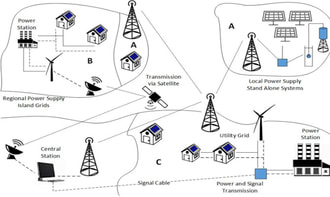|
Arctic Energy Security
The prosperity and security, and health of the Arctic depend on sound infrastructure in the built environment. Changes to land, human and marine environments are placing stress on both coastal and inland communities in the Arctic while generating interest for energy and mineral resources, increasing tourism, and opening up new fisheries and transportation routes. The global energy transition is placing greater pressures in Arctic and sub-Arctic regions as sources for renewable energy from wind and hydro, as well as mineral resources. Together, these trends provide new opportunities for sustainable development that have the potential to improve life for Arctic communities. |
|
Sustainable Energy Transitions with Smart Microgrids for modelling Energy Futures
Distributed generation along with smart grid applications are poised to make important contributions to the clean-tech sector and remote communities. The dependence on one source for energy supply does not prove reliable enough when the renewable resource, such as wind or solar, is variable, creating a dependence on external fuel supply and a vulnerability to foreign control. Developing an energy strategy through intelligent energy system simulation and optimization can help communities make informed decisions about their energy investments. This research is focused on developing sophisticated computer modeling and simulation supporting the design, operation and optimization of advanced power systems with storage for creating intelligent energy networks of any scale, from cities to entire islands. This work has been applied to a Brazilian island showcasing the transition to a smart energy island, involving energy generation, transportation, conservation, recapture, storage and utilization within the city, including electrical and thermal energy, and a mix of other renewable energy sources and related technology. |
|
Icing Mitigation for Wind Turbines in Cold Climates Wind power has gained substantial interest worldwide as a form of alternative and sustainable energy. The optimization of wind energy systems is critical in order to establish wind as a viable and economic resource. An immense potential of untapped wind resources exist in cold climates and is hindered by the uncertainty of the characteristics of the surrounding climatological conditions. One issue facing the optimization of wind power generation in cold climates is ice accumulation on turbine blades. This issue creates concern for efficient energy production, operational safety and when wind represents a significant energy mix ratio for a utility, a concern for grid integration. This research explores mitigation strategies to prevent or delay ice accumulation on wind turbines blades in an effort to enhance the understanding of the icing characteristics and to optimize wind turbine systems in cold climate conditions. See Journal Publications:
|



